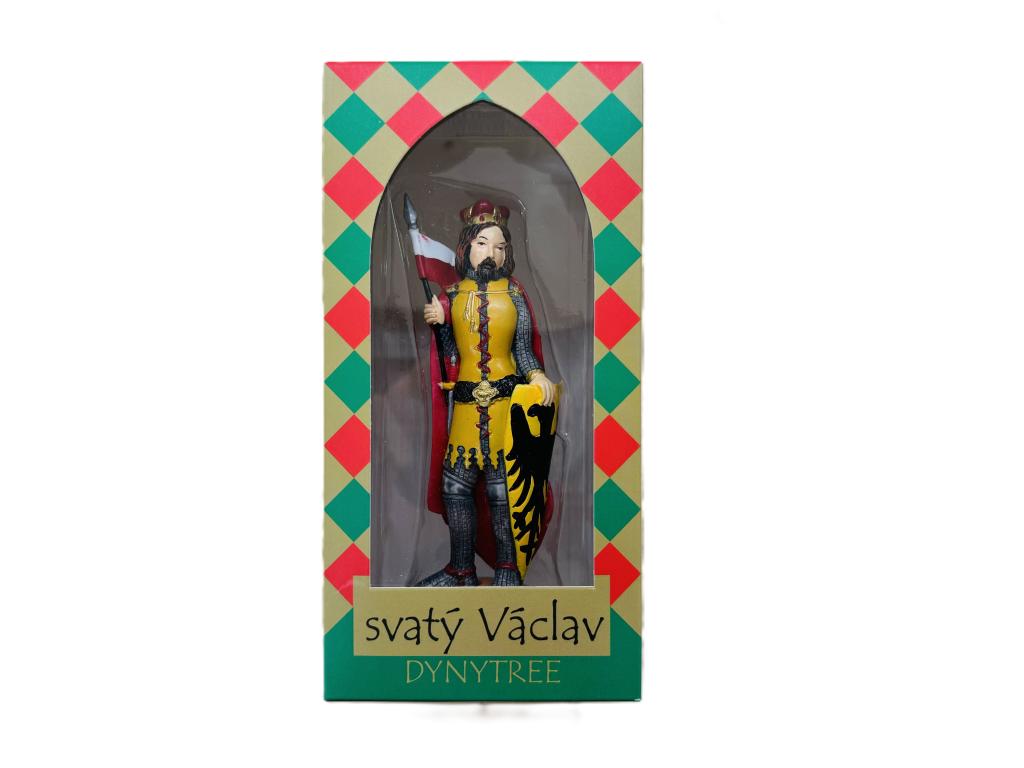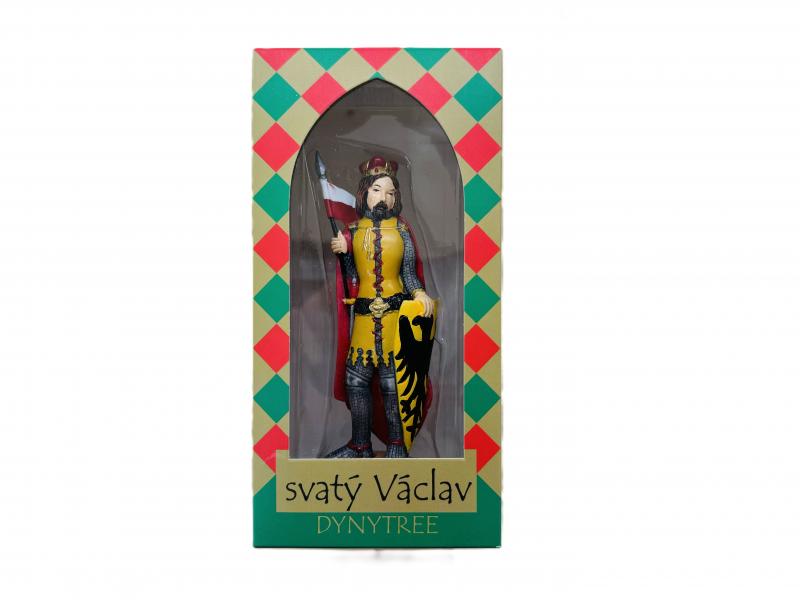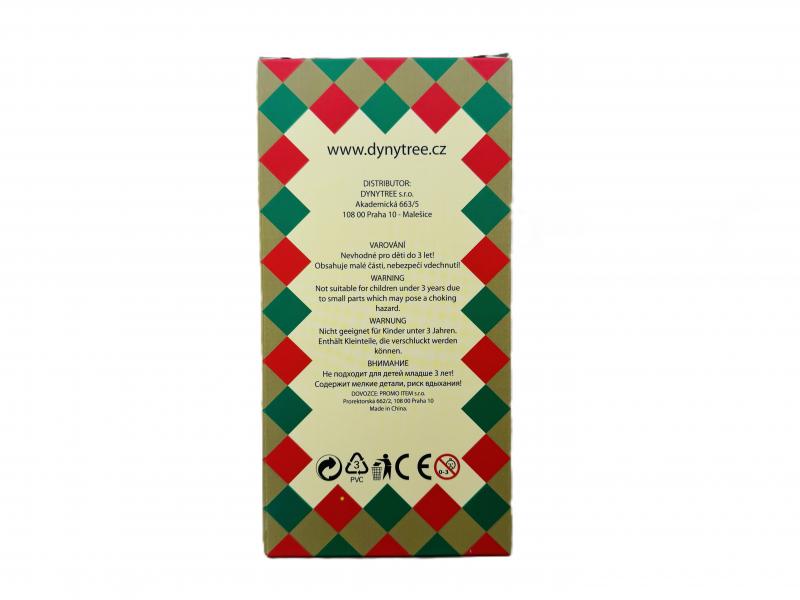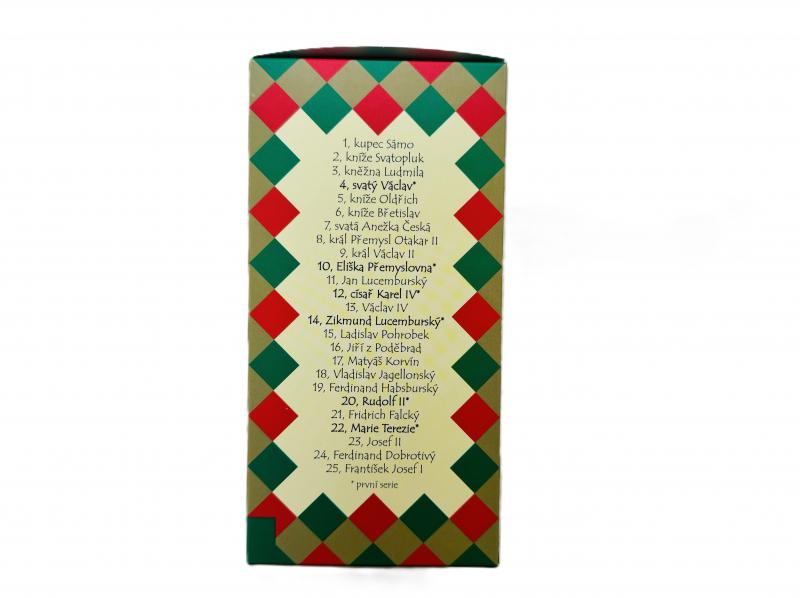K09 Statue of the King Wenceslas
The figure of St. Wenceslas represents the Czech prince and saint, the symbol of Czech statehood and the basic patron of the Czech country. Celý popis
Overview
The figure of St. Wenceslas represents the Czech prince and saint, the symbol of Czech statehood and the basic patron of the Czech country.
What to Expect
Description:
Figurine of St. Wenceslas, the symbol of Czech statehood and the patron saint of the Czech lands - a gift and souvenir for all history lovers and visitors to Bohemia.The figurine of St. Wenceslas represents the Czech prince and saint, the symbol of Czech statehood and the basic patron of the Czech country.
Details:
The figurine is made of plastic, hand-painted, 12 cm high, placed in a mica openable packaging and a paper box size 8x8x16 cm. The figure has EC type certificate 110460 T/NB - toy. The figure comes with a leaflet with short information about all 6 figures of the 1st series in Czech, English and German.
Biography:
The exact date of St. Wenceslas' birth is unknown, historians currently assume the year 907. Prince Wenceslas was the eldest son of Prince Vratislav and his wife Drahomira, descended from the Havolans. Václav's grandfather was the first historically documented Přemyslid ruler of the Bohemian lands, Prince Bořivoj I. And his grandmother was Princess Ludmila, later declared a saint. We do not know whether Ludmila came from the Pšovan family or rather from Serbia.After the death of Prince Vratislav in 921, Prince Wenceslas ascended the throne. However, he is not yet an adult, only about thirteen years old, and so he is brought up by his grandmother Ludmila in a Christian school in Budč. Wenceslas is educated in Slavic religious literature, which is more befitting a monk than a future monarch. He was allegedly taught by Slavic priests in Old Slavonic, Latin and Greek. Since illiteracy was common among rulers at this time, this claim by the chroniclers is somewhat implausible. According to the legends, Ludmila is a good Christian, a protector of the poor and needy, while Wenceslas' mother Drahomira remains a pagan.
There is a dispute and conflict between the two women. Princess Drahomíra wins and Ludmila retires to the Tetín fortress. Two assassins, allegedly sent by Princess Drahomira, arrive there and strangle Ludmila with her own veil. Princess Ludmila is declared a saint in 921.In the meantime, Prince Wenceslas has come of age and takes over the government himself. He first banishes his mother to Buda, but later they reconcile and the princess returns to her son. At this time the situation in the Bohemian principality is complicated. Bohemia was gradually becoming isolated from the influence of the Saxons and Bavarians. But, of course, their rulers did not want to admit this, and so in 929 the combined Saxon and Bavarian armies attacked Bohemia and penetrated as far as Prague without much trouble. Prince Wenceslas wanted to prevent the plundering and pillaging of the country and preferred to submit and negotiate a peace treaty. In later times, Wenceslas was reproached for having agreed to pay an annual fee of 500 talents of silver and 120 oxen to Bavaria. Historians today, however, believe that this fee dates from a much earlier time and that Wenceslas had nothing to do with it. On the contrary, the conclusion of the peace with Henry I Ptáčník brought Wenceslaus recognition as an important political partner and enabled the prince to firmly organize the church in the Bohemian lands. Henry gave Prince Wenceslas the relic of St. Vitus and the prince had the Rotunda of St. Vitus built for him at Prague Castle.We do not know many specific details, apart from religious legends, about the life of Saint Wenceslas. Neither the date of his birth nor the date of his death is historically documented. Prince Wenceslas was probably married, but his wife did not bear him a son. Legends sometimes mention a son Zbraslav, but the prince could have fathered him probably with his concubine.Throughout Wenceslaus's reign there were disputes between him and his younger brother Boleslav. According to some historians, these were questions of religion, while others suggest that the core of the disputes lay more in questions of the internal organisation of the state. When Wenceslaus defeated one of the neighbouring princes militarily, he was content with a promise of dependence. Instead, Boleslav wanted to take firm control of the whole territory, overthrow the other princes and install princely administrators in their places.
The taxes collected from these dependent territories could be used to build up an army and get rid of the shameful dependence on Saxony. This was precisely the policy that Boleslaus pursued when he became Prince of Bohemia.According to legend, Boleslav conceived the intention of having his brother Wenceslas murdered and then taking over the government himself. This event took place on Monday, 28 September 935 in Stara Boleslav (the year 929 was previously given). Boleslav is said to have invited his brother himself to the christening of his son at his residence in Stara Boleslav. The murder occurs in the morning when Prince Wenceslas enters the door of the Boleslav church. Here he is attacked by his brother Boleslav himself, but is disarmed by the prince. He cries out for help, his hidden companions come running and kill the fleeing prince. Prince Wenceslas is said not to have had time to hide in the church, but merely grabbed hold of the ring on the church door and died.
This is a rough reconstruction of Václav's death. After his death, Boleslav became the Bohemian prince and began to change his style of politics.After the death of Prince Wenceslas, there were rumours of his miracles, some of which were supposed to have taken place during his lifetime. The rebellious Prince Radslav of Kourim had a vision during a battle and saw the golden sign of the cross on Wenceslas' forehead and two angels at his side, so he surrendered to the prince. Further on, at the royal court, Wenceslaus prayed for a long time and did not appear in time for the council. King Henry the Birdsman was angry and ordered that the prince be ignored by everyone when he entered the hall. But on entering the hall, the king is said to have seen a golden cross on Wenceslaus' forehead and two angels at his side, threatening the king. The king was startled, and rose and cordially greeted the prince and presented him with a gift. After Wenceslaus' death, his body was transported from Stará Boleslav to Prague Castle, but the carriage with the coffin stopped in front of the prison, but no force could move the carriage to continue its journey.
It was only when it was discovered that an innocent man was confined in this prison, and he was set at liberty, that the procession moved on. Such and other miracles were attributed to Prince Wenceslaus, especially after his canonization after 975. Stories of his peacefulness, piety, and love for his fellow man were inserted into his biography. According to legend, St. Wenceslas himself grew and pressed mass wine and baked the hosts himself. He had gallows cut down, freed prisoners and slaves, gave generous gifts to the poor and comforted the sick. He built churches and cut down pagan idols. Several legends about the life of St. Wenceslas have arisen, suggesting that veneration of St. Wenceslas was widespread as early as the tenth century. Saint Wenceslas is the only Czech saint whose feast day -28 September - is a feast day listed in the worldwide calendar of the Roman Catholic Church.Prince Wenceslas' body was taken to Prague Castle three years after his death and is buried in St. Vitus Cathedral. The skull of St. Wenceslas is displayed on important anniversaries of the Czech nation.
The St. Wenceslas tradition has played an extraordinarily important role in Czech national history - and mostly a positive role. Saint Wenceslas became the patron saint and protector of the Czech lands. According to legend, he is the commander of the troops waiting at Mount Blaník to come to the rescue in the nation's worst times. The figure of St. Wenceslas inspired many artists, for example Petr Parléř to create a statue for the St. Wenceslas Chapel, and our figure is based on this statue. The St. Wenceslas cycle is on the walls of Karlštejn Castle. St. Wenceslas is also called the Czech royal crown. Very famous is Myslbek's equestrian statue of St. Wenceslas, located on Wenceslas Square in Prague and looking down on historical events under its feet. St. Wenceslas is one of the most important figures in Czech and Moravian history.
Availability:
Pick up your product at any time from 09.00 till 16.00 at our office GET PRAGUE GUIDE at Maiselova 5, 110 00, Prague 1 or we can send it to your address via post (the shipping is not included in the price of the item).Customer service phone number +420 725 744 770Thank you, your GetPragueGuide




